Buddhist Mountain Monasteries in Korea

Definition of “Sansa, Buddhist Mountain Monasteries in KOREA”
Buddhist monasteries nestled in mountains in Korea, called Sansa, are multifunctional religious facilities serving as home to the religious practices, beliefs and daily living of monks and laity.
Numerous temples were founded on the Korean peninsula from the 7th to the 9th centuries as various schools of Mahayana Buddhism were introduced through China and subsequently adopted. As opposed to many temples located in Gyeongju, then capital city of Silla, the seven temples inscribed on the Word Heritage List were established in mountains. From the 7th century the monasteries started to be established in mountains, including Tongdosa, Buseoksa and Beopjusa Temples which led religious activities. Tongdosa Temple was founded by the Venerable Precepts Master Jajang in the Vinaya (Gyeyul) tradition; Buseoksa and Bongjeongsa Temples were founded by the Avatamsaka (Flower Garland) Sect; and Beopjusa Temple was founded by the Dharmalaksana Sect (Beopsangjong). As Seon Buddhism (Dhyana School), introduced in the late 8th century, became popular, many temples started to be established in famous mountains deemed geographically ideal for the Seon (Zen) practice. They include Magoksa, Seonamsa and Daeheungsa Temples. Sansa have since continued to perform their due roles as mountain monasteries up to the present day, testifying to the changes in Korean Buddhism.
Numerous temples were founded on the Korean peninsula from the 7th to the 9th centuries as various schools of Mahayana Buddhism were introduced through China and subsequently adopted. As opposed to many temples located in Gyeongju, then capital city of Silla, the seven temples inscribed on the Word Heritage List were established in mountains. From the 7th century the monasteries started to be established in mountains, including Tongdosa, Buseoksa and Beopjusa Temples which led religious activities. Tongdosa Temple was founded by the Venerable Precepts Master Jajang in the Vinaya (Gyeyul) tradition; Buseoksa and Bongjeongsa Temples were founded by the Avatamsaka (Flower Garland) Sect; and Beopjusa Temple was founded by the Dharmalaksana Sect (Beopsangjong). As Seon Buddhism (Dhyana School), introduced in the late 8th century, became popular, many temples started to be established in famous mountains deemed geographically ideal for the Seon (Zen) practice. They include Magoksa, Seonamsa and Daeheungsa Temples. Sansa have since continued to perform their due roles as mountain monasteries up to the present day, testifying to the changes in Korean Buddhism.
Temple Locations
Outstanding Universal Value(ouv)
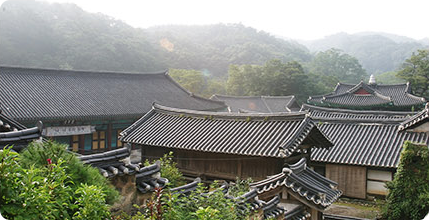 Seonamsa Temple
Seonamsa Temple-
The seven temples comprising Sansa, the Buddhist Mountain Monasteries in Korea, were founded by the Vinaya (Gyeyul), Dharmalaksana, Avatamsaka and Dhyana (Seon) Sects or Schools in the 7th-9th centuries when the foreign, adopted religion started to take roots and form locally as Korean Buddhism. The Buddhist sects prospered further in the Goryeo period (918-1392), but were forcibly merged into the Seon and Doctrinal Orders under the anti-Buddhist policy of the Joseon period (1392-1910). The histories of the Buddhist circle as experienced from within were reflected in the sangha education both for the Seon and Doctrinal Schools, which has been carried on to the present.
In addition to the Seon practice and doctrinal studies, monks share all kinds of duties to manage Sansa, which is one of the training courses to become monks. They also participate in the work to construct and repair temples as well as producing Buddhist artifacts.
- After repeated wars in the mid-Joseon period, monks engaged in the communal work to restore damaged temples as well as conducting religious services and contributing to social integration. Amid the sharp reduction of state subsidies to temples, they also had to exert strenuous efforts to secure economic self-reliance of the temples, which helped the Buddhist order sustain itself during the Joseon dynasty.
Sansa are a composite space for the Buddhist education, practice and daily life, and a relic that preserves tangible and intangible properties testifying to the history of Korean Buddhism. The continuity of the Buddhist religious community of monks and laity that has maintained its religious faith and practices without interruption lends evidence to the outstanding value of Sansa. 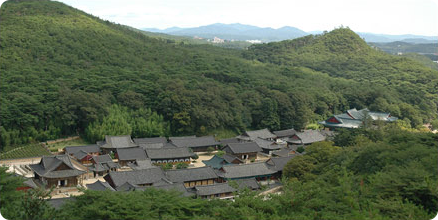 Tongdosa Temple
Tongdosa Temple
Temple Spaces
- Sansa have the architecture that embodies their spirit. The spirituality of Vinaya (Gyeyul) Sect is mirrored in the Diamond Precepts Platform and Great Hero Hall of Tongdosa Temple, and the Buddha’s statue at the Hall of Infinite Life at Buseoksa Temple facing the east accentuates the belief that Amitabha Buddha comes from the west, with the multiplatform structure of the temples indicating the practice based on the Flower Garland Sutra. Bongjeongsa Temple’s two open-yard configuration for its two main halls, the Hall of the Great Hero and the Paradise Hall (Geungnakjeon), accommodates both the worship of Sakyamuni and Amitabha, and the colossal gilt-bronze statue of Maitreya (Bodhisattva of Future Buddha) at Beopjusa Temple represents the core of a temple layout based on the Dharma Characteristics School. The Treasure Hall of the Great Hero (Daeungbojeon) at Magoksa Temple and the Hall of the Great Hero at Seonamsa Temple are structures devoted to the belief of Sakyamuni, while the Pyochungsa Shrine at Daeheungsa Temple reflect a belief in patriotic Buddhism. Thus, the buildings of Sansa were arranged in consideration of religious practice as well as mirroring the philosophy and beliefs of the Buddhist sects.
-
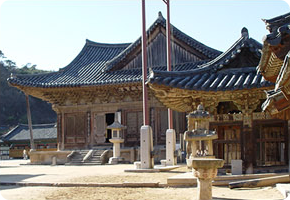 Daeungbojeon Hall of Tongdosa Temple
Daeungbojeon Hall of Tongdosa Temple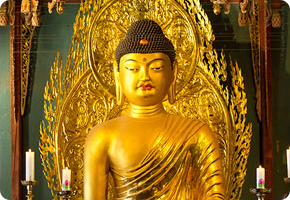 Amitabha Buddha Sculpture at Buseoksa Temple
Amitabha Buddha Sculpture at Buseoksa Temple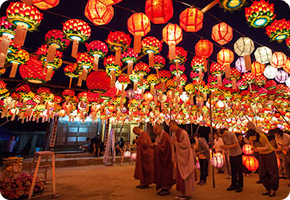 Prayer chanting ceremony at Bongjeongsa on Buddha's Birthday
Prayer chanting ceremony at Bongjeongsa on Buddha's Birthday
- The One Pillar Gate (Iljumun) stands at the entrance of each temple as a symbolic boundary between the sacred and the mundane worlds. The approach to the heart of the temple, passing through a series of gates, is a path of movement emphasizing the sacredness of the place, a feature that sets traditional Korean temples apart. The temple buildings are arranged in a geometric fashion whose natural order is manifest from the entrance to the mountain, past the One Pillar Gate and into the heart of the temple. In this way, the buildings philosophically and architecturally exhibit the development of Buddhism through different historical periods. The basic spatial layout of the Korean mountain monasteries is madang: an open yard surrounded by a main Buddha hall with a pavilion at its opposite and dormitories on each side. A spacious soil courtyard is laid out between the main Buddha hall and a pavilion, creating a scenic view. As the scale of temples was expanded, auxiliary halls were added near the main hall, and various halls enshrining indigenous deities, such as the Three Sages Shrine, Seven Stars Shrine and Solitary Sage Shrine, were also incorporated into the temple compound.
The mountain temples have no boundaries and hence are open to the surrounding environment. The buildings are regarded as elements of the mountain’s ecosystem, clustered and organically interconnected within logically defined areas. The temples have been expanded without damage to the original terrain of the mountain. As sacred and independent spaces, the temples are places where the monks carry out their daily lives and devote themselves to spiritual practice. At the same time, they are communal spaces which also function as places of worship for the general public. The buildings in the compound were erected in consideration of the natural topography, and thus are in harmony with the surrounding terrain and the natural landscape.
The space of the mountain monasteries is divided into the hall enshrining the Buddha, lecture hall for the practitioners’ study of Buddhist sutra, Seon (Zen) meditation center, dormitories for the monastery community and other places for religious practices and living. The monasteries represent the Buddhist doctrines through their architectural layout and their topographical relations with the surrounding peaks and other natural backgrounds.
The traditional Sansa preserve tangible and intangible Buddhist culture as a composite monastery for Buddhist practice and discipline. Practitioners and lay believers offer Buddhist prayers, recite Buddhist scripture, hold worship service and practice meditation in their community life at the monasteries. Most of the seven temples inscribed on the World Heritage List preserve the shape of the typical Korean Buddhist monastery with the lecture hall and Seon meditation center for monks.
